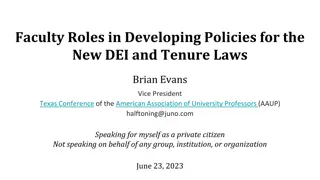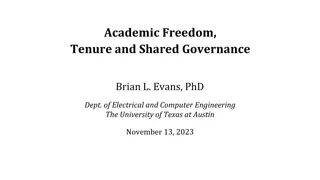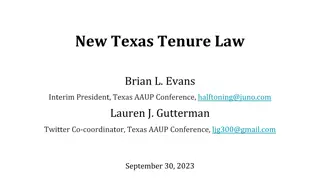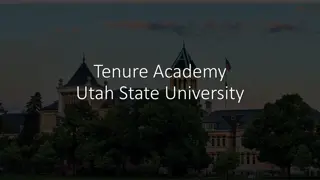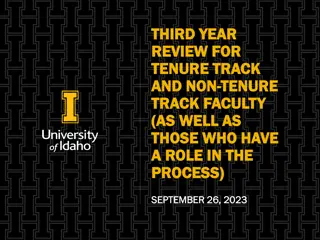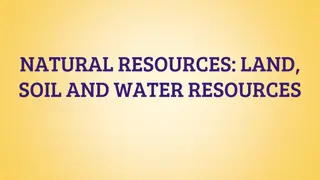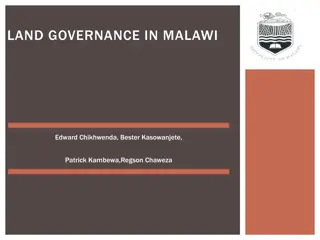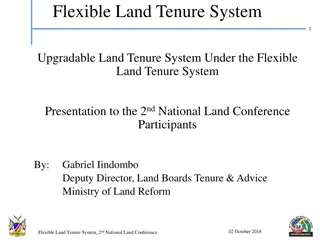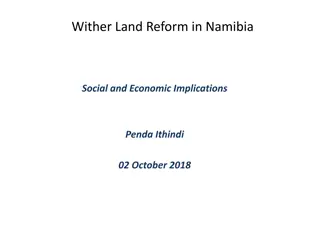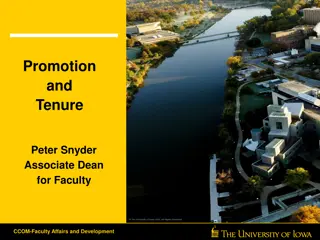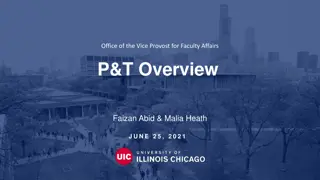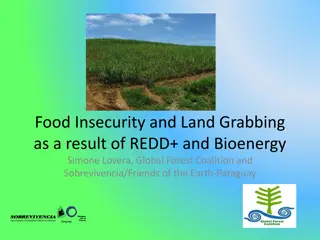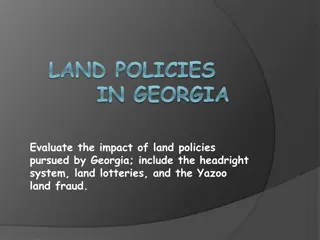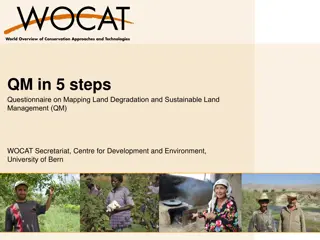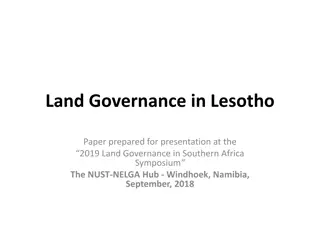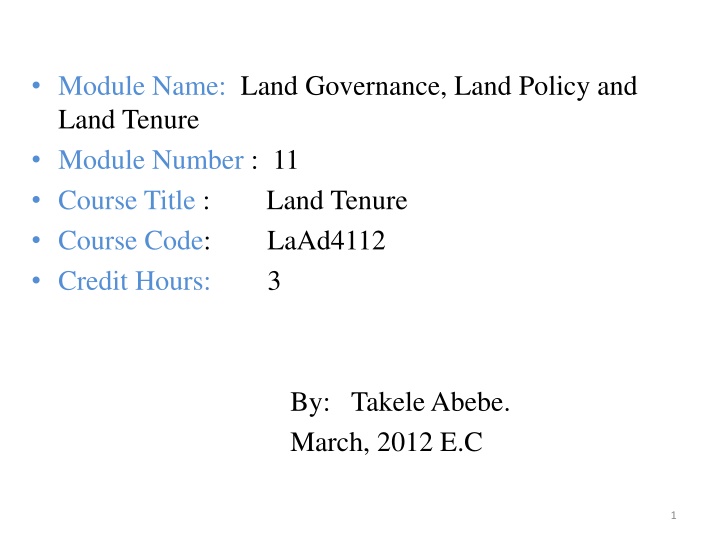
Importance of Land Tenure in Development Initiatives
Land tenure systems play a crucial role in addressing food security, poverty alleviation, and sustainable development. Understanding the significance of secure land rights is essential for improving livelihoods and ensuring equal access to resources.
Download Presentation

Please find below an Image/Link to download the presentation.
The content on the website is provided AS IS for your information and personal use only. It may not be sold, licensed, or shared on other websites without obtaining consent from the author. If you encounter any issues during the download, it is possible that the publisher has removed the file from their server.
You are allowed to download the files provided on this website for personal or commercial use, subject to the condition that they are used lawfully. All files are the property of their respective owners.
The content on the website is provided AS IS for your information and personal use only. It may not be sold, licensed, or shared on other websites without obtaining consent from the author.
E N D
Presentation Transcript
Module Name: Land Governance, Land Policy and Land Tenure Module Number : 11 Course Title : Land Tenure Course Code: LaAd4112 Credit Hours: 3 By: Takele Abebe. March, 2012 E.C 1
Chapter one Land Tenure 1.1 Concept of Land tenure is the mode by which land is held or owned, or the set of relationships among people concerning to land or its product. The relationship may be defined by legally (formal) or customarily (informal) law. A formal system is one created by statute while an informal system is an unwritten and customary one. Land tenure is the institutional (political, economic, social, and legal) structure that determines how individuals and groups secure access to land and all resources contained on it. Rules of tenure define how property rights to land are to be allocated within societies. They define how access is granted to rights to use, control, and transfer land, as well as associated responsibilities and restraints. In simple terms, land tenure systems determine who can use what resources for how long, and under what conditions.
Cont Land tenure is the system of rights and institutions that govern access to and use of land (Adams, 2001). It can be further defined as: the terms and conditions under which land is held, used and transacted and is one of the principal factors determining the way in which resources are managed and used and the manner in which benefits are distributed.
1.2. Importance of Land Tenure In response to the concerns for food security and poverty alleviation, development agencies and organizations are introducing strategies that help to build assets and promote the self-reliance of poor people and communities. Interventions include helping poor people protect and enhance their natural resource base, improving access to agricultural land through resettlement schemes, and ensuring food security of the vulnerable, including women, minorities and indigenous groups. In many cases, responses to concerns of environmental sustainability, social conflicts, and food security of the vulnerable are affected by land tenure and have an impact on land tenure. Failure to consider land tenure implications at the beginning of an intervention is likely to result in unanticipated outcomes and may lead to it not generating an improvement.
Cont Eradicating hunger requires increasing the access to food of a person or family. The extent to which individuals and families are able to be food secure depends in large part on the opportunities they have to increase their access to assets such as land, as well as access to markets and other economic opportunities. Land tenure is important in rural development interventions which place an emphasis on building people s endowments of assets so they can enjoy sustainable livelihoods. It is also important in rural development interventions that use a rights-based approach to programming. Such programming should ensure that causes which prevent people from enjoying their rights are eliminated or reduced
Cont When dealing with aid and development in rural areas, a rights- based approach to programming should address the rights to land that the beneficiary groups in the project or programme have. It necessitates identifying what rights are recognized within the project area, how these rights are organized, and whether adequate institutional arrangements exist to determine who has rights to land, for how long, for what purposes, and under what conditions.
1.3. Major Land Tenure Systems Rights may cover access, use, development or transfer and, as such, exist in parallel with ownership. On this basis, it is clear that the ways in which a society allocates title and rights to land is an important indicator of that society, since rights to land can be held to reflect rights in other areas of public life. 1.Private Land Tenure System: The assignment of rights to a private party who may be an individual, a married couple, a group of people, or a corporate body such as a commercial entity or non-profit organization. For example, within a community, individual families may have exclusive rights to residential parcels, agricultural parcels and certain trees.
Cont This system permits the almost unrestricted use and exchange of land and is intended to ensure its most intense and efficient use. Its primary limitation is the difficulty of access by lower income groups. Other members of the community can be excluded from using these resources without the consent of those who hold the rights. 2. CommunalLand Tenure System a right of commons may exist within a community where each member has a right to use independently the holdings of the community. For example, members of a community may have the right to graze cattle on a common pasture.
Cont 3. State/PublicLand Tenure System property rights are assigned to some authority in the public sector. For example, in some countries, forest lands may fall under the mandate of the state, whether at a central or decentralized level of government. The concept of public land ownership is largely a reaction to the perceived limitations of private ownership in that it seeks to enable all sections of society to obtain access to land under conditions of increasing competition. Although it has frequently achieved higher levels of equity than private systems, it has rarely achieved high levels of efficiency due to bureaucratic inefficiency.
Cont 4. Open accessLand Tenure System specific rights are not assigned to anyone and no-one can be excluded. This typically includes marine tenure where access to the high seas is generally open to anyone; it may include rangelands, forests, etc, where there may be free access to the resources for all. An important difference between open access and communal systems is that under a communal system non-members of the community are excluded from using the common areas.
1.4. Principal Forms of Land Tenure The two principal forms of land tenure systems are customary and statutory tenure systems. Customary land tenure system is governed by unwritten traditional rules and administered by traditional leaders. Active occupation or usage of a piece of land is the main evidence of ownership or an existing interest on the land. In customary tenure, access to land is contingent upon tribal or community membership controlled by the chief. Households have strong, exclusive residential rights, seasonally exclusive rights to arable land, and shared rights to grazing land and natural resources. Land is not alienable from the community trust, so it cannot be used as collateral for loans. Usually, however, an individual's land use rights are secure, subject to certain conditions, which include that the land be more or less continuously cultivated, subject to periodic fallow.
1.4.1. Customary Land Tenure System Customary land tenure is found in most parts of Africa, the Middle East, Melanesia and (once upon a time) NorthAmerica. It evolved from largely agricultural societies in which there was little competition for land, and therefore land had no economic value in itself, but where survival was often precarious and depended upon careful use of the land to ensure an ecological balance. In customary systems, land is regarded as sacred, and man`s role considered to be one of stewardship, to protect the interests of future generations. Allocation, use, transfer, etc, are determined by the leaders of the community according to its needs, rather than through payment, though some form of token amount (eg beer money, or cattle) is often extracted as a sign of agreement. With urban expansion, the system has become subject to commercial pressures and may only benefit members of the group. Customary land tenure in Ethiopia is experienced in pastoral areas and in tribal communities.
Cont The group on which rights of ownership is vested frequently is the clan, but if such a clan has a large population and access to extensive resources, it may be divided into sub-clans and the rights may be vested in the sub-clan. Each group lays claim to a territorial area the boundaries of which are identified by natural land forms such as hills, valleys, lakes/ponds, streams, etc. These territorial areas and boundaries have each a specific name in all pastoral societies. Pastoral production relies on periodic movement from one area to another depending on the seasons, and the condition of the resources. Thus many clans have access to pasture and browse in different locations during the dry and wet seasons.
1.4.2. Statutory Land Tenure System Statutory land tenure system is governed by modern law and supported by documentary evidence, such as a title deed or lease certificate, and administered by the government. Land ownership under the statutory tenure system is often built on freehold or leasehold entitlements to the land and offers exclusive rights to the owner, which guarantee land tenure security. Land rights in freehold include the ability to sell the land, rent it to others and to use it as collateral for a mortgage.
1.5 Land Tenure Security 1.5.1. Security of Tenure is the certainty that a person s rights to land will be recognized by others and protected in cases of specific challenges. People with insecure tenure face the risk that their rights to land will be threatened by competing claims, and even lost as a result of eviction. Without security of tenure, households are significantly impaired in their ability to secure sufficient food and to enjoy sustainable rural livelihoods. Security of tenure cannot be measured directly and, to a large extent, it is what people perceive it to be. The attributes of security of tenure may change from context to context.
Cont For example, a person may have a right to use a parcel of land for 6 month growing season, and if that person is safe from eviction during the season, the tenure is secure. By extension, tenure security can relate to the length of tenure, in the context of the time needed to recover the cost of investment. Thus the person with use rights for 6 months will not plant trees, or invest in irrigation works or take measures to prevent soil erosion as the time is too short for that person to benefit from the investment. The tenure is insecure for long-term investments even if it is secure for short-term ones.
1.5.2. Insecurity of Land Tenure Insecure land tenure covers a wide range of local situations, from total illegality to various forms of tolerated occupation, or occupation legitimized by customary practices. When insecurity of tenure acts as a disincentive to long term investments in soil conservation, irrigation, and the like, land quality can deteriorate and agricultural productivity suffer. For this reason, tenure reform is frequently a component of development projects aimed at enhancing food security and sustainable livelihoods for the rural poor.
1.5.3. Land tenure Reform and Land Reform Land Tenure Reform - Land reform may also involve Changes in the tenure of the land, that is in the manner in which rights are held, thus abolishing complex traditional and customary rights and introducing more simple and streamlined mechanisms of land transfer. A fundamental goal is to enhance and to secure people s land rights. This may be necessary to avoid arbitrary evictions and landlessness Tenure reform is distinct from land reform in that it does not redistribute parcels of land, but rather makes adjustments in the rights to hold and use land. Examples of land tenure reforms include strengthening informal tenure rights by making them legally enforceable and transforming state-issued permits for specific land uses into leases that provide more protection for users of the land.
Cont Land reform (also agrarian reform, though that can have a broader meaning) involves the changing of laws, regulations or customs regarding land ownership. it may consist of a government- initiated or government-backed property redistribution, generally of agricultural land. Land reform can, therefore, refer to transfer of ownership from the more powerful to the less powerful such as from a relatively small number of wealthy (or noble) owners with extensive land holdings (e.g. plantations, large ranches, or agribusiness plots) to individual ownership by those who work the land. In short, Land reform: the various processes involved in altering the pattern of land tenure and land use of a specified area (land consolidation, Land Restitution and land redistribution).
1.5.4. Sources of Tenure Security An important source is the community and its specific groups such as local farmers organizations and water users associations. When neighbors recognize and enforce a person s rights, that person s security increases. In many customary tenure arrangements, people gain property rights through membership of social communities. Maintaining property rights validates membership in the group just as much as membership facilitates the acquisition and safeguarding of property rights. Another source may be the administrative state and the formal legal system. The state may provide security in general by affirming the rights that people hold as well as through specific measures such as providing protection against trespass.
Cont Security is often seen to come from protections provided through land registration and cadastral systems, with adjudication of disputes taking place in the formal court system. In some countries, security can also be provided by coercive structures such as warlords that emerge in the absence of an effective state during periods of civil unrest. Of course, this is not a desirable source of security as these structures may in turn prevent the development of strong communities and legal systems necessary for good governance .
1.5.5. Factors That Contribute to Relative Degree of Land Tenure Security Three main factors contribute to the relative degree of security created by a given property right be it statutory or customary - whether in respect of land or other asset: i. Clarity in duration and content of rights: Duration of the right is a factor that gives it strength. Very limited rights, such as the right to collect fuel wood or the right to graze animals, can be secure and strong if they are clear in content and endure over time. Various use rights may be given in perpetuity or for a long period of time. ii. Certainty about the right holders and independent control of rights: It is essential to know the boundaries of the land; the quantity and characteristics of assets and things to which the rights apply; and who is entitled to those rights.
The holder of the right should have the capacity to dispose of a right as she/he likes, such as using it for cultivation or for other uses, transferring it to others or using it as collateral for credit in the times of crises or to invest in an income-generating activity. iii. Guarantee of enforcement against interferences by other actors: The key factors that influence the realization of rights are the availability and accessibility of mechanisms that allow people to complain in case of a dispute. The holders of property rights should be able to exclude or control the access of outsiders to their land and property, including the state itself. This means that there should be accessible, affordable and fair procedures and mechanisms allowing people to seek protection of their property rights, to solve disputes and to appeal decisions made by government officials.
There may be circumstances that justify actions by the state which can limit people s land and property rights. When the existing rights are limited or taken away, this should be done in accordance with established conditions and procedures and with appropriate compensation. Government should not be able to arbitrarily assign conflicting rights to others over the same land or assets (e.g. assigning logging concessions in a community land or transferring property of a deceased person to others rather then to his or her family members).
1.6 PROPERTY AND PROPERTY RIGHTS What is property ? The term property is often identified with a tangible thing that people have (e.g. a piece of land, a house, a watering can, a shovel). In legal terms, however, property is not an object; it is a relationship between a person and things. In other words, property refers to the interests or rights which a person can claim and exercise over certain things (i.e. proper to a person or group of people). It can be the interest or the right to use a thing, to dispose of it in different ways, to sell it or to give it away. Property is also the relationship between different people with respect to things; it refers to the interest or the right to exclude or to include others in the use or benefits of certain things. Note in this context that property does not necessarily mean owning .
Cont Property rights refer to a bundle of rights on the use, control, and transfer of assets, including land. Real property, represents all interests, benefits, and rights inherent in the ownership of the physical real estate; the bundle of rights with which the ownership of real estate is endowed whereas personal property is a tangible object that is considered by the people as being personal such as car, furnishers, machinery, equipment, and all tangible propitiates that are not categorized as real estate. Rights are intangible even though they deal with tangible objects such as a piece of land. Thus, an individual person may own the abstract right to sell a piece of land.
Cont This right will be passed to the purchaser on sale of the freehold. Although this process may be referred to as land transfer, it is the ownership right that is transferred, not the physical commodity as this is immovable. Land rights are sometimes referred to as interest in land, because when there is a transfer of land what actually happens is that interests in land are transferred from one person to another. Land rights are not a single entity owned by only one person at a time. Rather, land rights in a unit of land can be equated to a bundle of sticks. Each individual stick defines a way in which the land may be used, the profit that may be derived from it, or the manner in which some or all of the rights may be disposed of, to other people, or to organizations'.
Cont The rights over land can be divided in to parts, some of which are in the possession of the main landowner but some of which such as a rights of way over the land, may belong to others. They have been described as a bundle of sticks, each stick identifying a particular right. This bundle of rights contains all the interests in real property including the right to use real estate, sell it, lease it, enter it and give it away, and each stick can be separated from the bundle and traded it in the market. Although there is a complete bundle for each piece of land, that whole bundle is not normally in the possession of one individual.
Cont Property rights may include the right to: Occupy, enjoy and use Restrict others from rent Sell, buy or inherit Develop or improve Cultivate or use for production Rent, sublet, or sublet and fix the rent (e.g. free of rent control) Realize a pecuniary benefit from increased property values or rental income Access services Access formal credit
WHO HOLDS LAND AND PROPERTY RIGHTS? In general terms, holders of land and property rights can be: Individual Groups of individuals Legal persons ( organizations such as banks) State ( such as municipality).
WAYS TO ACCESS TO LAND People use a wide range of strategies to gain access to land. These include: Purchase, often using capital accumulated while working as migrants in urban areas. Adverse possession or prescription (the acquisition of rights through possession for a prescribed period of time). In some countries, this may be the only method for small farmers to gain formal access to vacant or abandoned land and to bring it into productive use. Leasing, or gaining access to land by paying rent to the owner. Leases from the government Sharecropping, or gaining access to land in return for paying the owner a percentage of the production. Inheritance, or gaining access to land as an heir. Squatting, illegally own the land.
Chapter Two Land Tenure and Livelihoods Land Tenure and livelihoods, What is livelihood? Livelihoods are the way in which households and communities derive food, shelter and clothing to sustain their living. E.g Farming, trade, employment in different sectors, wage labour, etc. Land rights have increasingly come to be perceived as embedded within the broad spectrum of human rights and are related to the notion of rights to food and to existence. Sustainable livelihoods exist when systems of human livelihood can cope with and recover from stresses and shocks, and maintain or enhance their human capabilities and assets both now and in the future, while not undermining the natural resource base. Livelihood strategies are the ways in which assets or resources are used to generate access to food and other basic needs; Coping strategies are short-term measures applied when a household or community does not have sufficient income or food to meet all its essential needs.
Land Tenure and livelihoods Chambers (1988) defined livelihood as adequate stocks and flows of food and cash to meet basic needs. Security of livelihood includes access to the means to produce the food or generate the income to meet those needs. Access to land and land tenure security are regarded as key to human livelihoods. Access to land and land tenure relations are critical where communities depend on control of land to ensure their food security. Food security is the capacity of households, communities and the state to mobilize sufficient food, through production, acquisition and distribution, on a sustainable basis. Food security thus depends on the land resources available to the household or community and their ability to mobilize resources for the production and/or distribution of food to achieve an active and healthy life.
2.1 Livelihood Options and Land Tenure There are a variety of livelihood options for smallholders in Africa. The predominant livelihood activity is smallholder semi- subsistence farming, which is practiced by a variety of indigenous people. Most households rely on cash and subsistence incomes from a number of sources that include irrigated and rain fed cultivation, livestock production, tree production, and other miscellaneous activities, such as honey production. Households also depend on a variety of non-farm livelihoods, such as woodland activities, fisheries, trading, value adding processing, wage incomes, and remittances. The agricultural activities are affected by unfavorable climatic conditions, poor markets and infrastructure services, and unfavorable physical conditions (poor soils, land degradation caused by cultivation on sloping land, deforestation).
Cont Unequal access to land and insecure land tenure has had the most profound effect on the livelihoods of smallholders. Under circumstances of extreme food insecurity (i.e. famine), a major concern is often to preserve productive assets in order to facilitate eventual recovery and to maintain future security. Reduction of current food consumption is undertaken in order to avoid having to dispose of key productive assets or take other actions which will impair the household s long-term, income- generating capacity.
2.2 Land Distribution and Ownership Patterns Land ownership pattern as the most comprehensive and complete relation that can exist in respect of anything. It is the fullest amplitude method of rights of enjoyment, management, and disposal over property (Nwabueze, 1972). One fundamental feature of ownership is the right of alienation of a property without seeking anybody s consent. A person owning a parcel of land has the right to take decisions on the land without consulting anybody. Land ownership pattern is the perception of having secured rights to land and property on a continual basis, free from unreasonable interference from outsiders, as well as the ability to reap the benefits of labour and capital invested either in use or rented to another (Quan, 2006) .
Cont Thus, the way in which access to land is regulated, property rights are defined, and ownership conflicts are resolved has bread implications beyond the sphere of agriculture production. For a significant proportion of the world s poor on the agricultural sector, the distribution of land in rural areas is an important issue for poverty alleviation. In particular, the access of low income rural households to adequate amount of land is crucial in sustaining their livelihoods. Many countries have undertaken land reform programmes to improve the access of households to land as well as decrease inequality in rural areas. However in Africa, the legacy of the oppressive and racially-based policies of colonial governments is still reflected in the dualistic land tenure systems and inequitable land distribution patterns.
Cont In South Africa, where 65000 white farmers, who derive from only 5% of the population, own almost 87% of the land . The mean amount of land held per person for blacks is slightly more than one hectare and 1570 hectares for whites. In Zimbabwe, until very recently, approximately 4500 white commercial farmers controlled 31% of the country s prime land, or about 42% of the agricultural land, under freehold tenure, while 1.2 million families subsist on 41% of the country s area. In Namibia, some 4000 white settler freeholders own 6400 farms, with an average size of 5700 hectares each. On the other hand, smallholder farming covers 34 million hectares and supports 140 000 families (about 50% of the population). Countries such as Kenya, Algeria, Egypt and Ethiopia have histories of intense conflict over uneven land distribution.
Cont However, numerous other countries have lower degrees of land distribution inequalities. For e.g in Botswana the State controls 96% of the land, 25% of which is directly owned by the State, while 71% is controlled through the tribal land boards. In post independence Tanzania, the nationalization of freehold lands, as well as villagization, gave birth to new problems of land conflicts and land tenure insecurity. Land was nationalized through the 1963 Freehold Titles (Conversion and Government Leases) Act, which converted all freehold titles, totalling about 1 million acres, into 99-year government leaseholds . This policy, meant to redress colonial expropriation and inequitable control of land, was implemented without much conflict
Cont In some parts of Central Africa the scarcity of productive lands is the source of conflicts. In Rwanda and Burundi, scarcity of land is at the root of the civil unrest. Rwanda is the most densely populated country in Africa and has only about 52% of Rwanda (1 385 000 ha) is estimated to be arable and out that the average plot size was declined from 2 hectares in 1960 to 1.2 hectares by 1984 (Kairaba, 2002) . About 60% of all agricultural holdings in Rwanda are less than 0.5 hectares in size. Access to land is also a major problem in Burundi, where population densities ranges from 41-1 000/km2. The high levels of inequality observed in a country often leads to instability and violence.
2.3 Land Markets and Sustainable Livelihoods What is land market? It refers to a land transaction where either ownership right (Private right) or use rights are transferred from one owner to the other. Benefits from land markets is obtained through: land sale, mortgage, lease, share cropping. Role of secured land tenure in land markets: where there is secured land tenure and efficient land administration there is a better land transaction, good land ownership security. Even though land can be accessed through a wide variety of mechanisms, land transactions can play an important role by allowing those who are productive but are either landless or own little land to access land.
Cont Those who have adequate land can benefit from the land market either by renting, leasing, share cropping or even selling land and starting new livelihoods . Land markets also facilitate the exchange of land as the off-farm economy develops and, where there is a supply of credit, provide a basis for the use of land as collateral in credit markets. Efficient land markets influence investment in land, and food security. Capital market imperfections and policy distortions have, in many instances, led to speculative land accumulation rather than better access to land by the productive poor. in this case, land transactions may fail to contribute to improving productivity and equity.
Cont Government intervention in land markets and a more careful review of the factors affecting different types of land market transactions before proceeding to policy recommendations is very important. Non-market transactions mostly refer to the transfer of land rights through processes such as gifts, borrowing and the inter- generational mechanism of inheritance. Generally non-market transactions relate to transfer of land rights in customary tenure systems, although increasingly, the evidence shows a steady development of informal land markets in that sector (Moyo, 2000; Place, 2002). This means that non-market transactions have increased the flexibility of customary systems to cope with population pressure, commercialization of agriculture and other driving forces.
2.4 Land Tenure and Poverty What is poverty? Is it lack of access to land and other resources? Access to land and poverty- are they related? How does land tenure affect poverty? Is there a relationship between land tenure and poverty? Land is fundamental to the lives of poor rural people. It is a source of food, shelter, income and social identity. Secure access to land reduce vulnerability to hunger and poverty. But for many of the world s poor rural people in developing countries, access is becoming more tedious than ever. Security of tenure is important for poverty reduction because it allows poor people to grow more food, harvest products for consumption or trade, invest more in economically productive activities, or use property to obtain credit. Some studies report that investment doubles on land where tenure is strengthened (Feder 2002, cited in Deininger et al. 2003:8).
Cont Recent research also indicates that countries with equitable, efficient land tenure systems, ensuring property rights for both women and men, tend to achieve faster, more sustainable economic development with high levels of food security, health, and welfare (FAO 2002:5; Deininger 2003:17-20). On the global scene, 1.2 billion people live in extreme consumption poverty; 25% and 66% are from sub-Saharan Africa and Asia respectively. The empirical evidence of poverty trends and tendencies in relation to land tenure insecurity is strikingly clear in Africa.
Cont In 2002 an estimated of more than 45% of sub-Saharan Africa s population lived in poverty. An examination of poverty statistics in East and Southern Africa indicates that the majority of rural people in these regions exist below the national poverty line. Land in Africa is a critical constraint on poverty reduction because most rural households rely on land for the reproduction of future generations, since the industrial and service sectors do not currently provide alternative opportunities for survival. Apart from its value for agricultural purposes, to realize subsistence production and cash income, land also provides for basic household needs, such as energy, through fuel wood, medicines, housing materials and nutrition.
Cont Unequal control over land is therefore a critical factor in formulating poverty reduction policy and in the political process of democratic transition in Africa. Where access to land is highly concentrated and where a sizeable part of the rural population lacks sufficient land to earn a livelihood, special measures may be necessary to tackle the problem of persistent poverty. The response to poverty should start by the poor being recognized as actors who shape their lives even under conditions of hardship and destitution. In this view, poverty derives from a deficit of power rather than a lack of money. Land offers a wedge for the poor to mobilize their own power to chart their development destiny.
Cont Any attempt to mitigate poverty will, therefore, have to be centered on a reinforcement of rights and opportunities arising from land and agriculture. This is particularly true for the poor, who are often legally marginalized. In many places, they have no access to tenure, income and influence, despite the fact that they carry most of the burden of everyday life and often have to sustain families by themselves. For the poor, a basic rights strategy, rather than a basic needs strategy, may help to overcome the constraints to self- organization. In the countryside, conflicts are often centered on rights to land, access to water, forests, undestroyed habitats, and confronting landowners.
Chapter Three Land Tenure and Food Security Land Tenure, Agriculture and Food Security Land Tenure and Land Use Agriculture Protected Areas Pastoralism Land-Use Regulations
3.1 Land Tenure, Agriculture and Food Security The economies of most African countries largely depend on land- based activities, such as agriculture, mining and tourism. Agriculture has direct linkages to food security, while mining and tourism are indirectly linked to food security through their competing demands for land use and their potential to supply incomes for food consumption. The impact of land tenure on food security and sustainable natural resource management is complex. Agriculture in Africa can be classified as bimodal - divided into smallholder and large- scale/estate agriculture. The underdeveloped state of smallholder agriculture in most African countries has largely been shaped by economic policies which disfavour them but promote the larger farmers.

